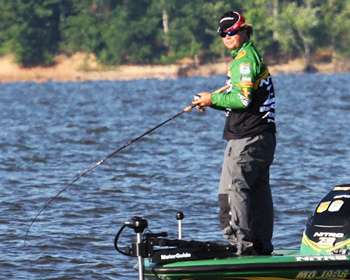
In 2007, Elite Series pro Tim Horton put on a virtual cranking clinic at the Champion's Choice on Lake Champlain. Horton's 13-pound margin of victory, while not a record, was enough to stun even the most hardened of fishing fanatics.
Horton's secret? Well, aside from a magical rockpile, it was a well-tuned crankbait, something Horton knows a thing or two about. "A lot of people will just open up the package and start throwing the crankbait without putting a lot of thought into it," he says. "I've learned over the years that there's a time and place for almost everything in bass fishing, and I tend to view throwing a crankbait in the same way."
One of the easiest decisions Horton makes, where cranking is concerned, is knowing when to run silent — that is, when to fish a crankbait that doesn't have a rattle. "When fish are really aggressive, that's when you want that rattle," he says. "If you're fishing on a lake that's heavily pressured, you usually don't want a rattle in your crankbait. You want the bait to get on top of the fish before they know it's coming. If fish have been heavily pressured, or if they've grown accustomed to hearing that rattle, they won't react unless they're in a strong feeding mode."
By running silent, Horton explains that the crankbait will enter the bass' strike zone unnoticed and create a reaction bite. "If you're able to pinpoint where fish are holding on a point or ledge, you can bring the crankbait right over their backs," he says.
"A lot of times, if you can get that first bass to react, the whole school will fire up. If you were to try that with a rattling crankbait, chances are you would scatter the school without ever getting as much as a sniff."
Horton reveals that there's not a certain time of the year when a silent crankbait will outperform a rattling version. Instead, angling pressure creates the perfect situation, regardless of season.
"For me, the last day of a multiday tournament is when I break out the silent crankbait," he says. "I learned this at Lake Guntersville, where loud lipless crankbaits are so popular during the spring. I noticed that when I would be fishing a multiple-day tournament, bass would get off that bite on the third or fourth day. The fish would still be there, but they wouldn't react to that loud bait."
While it's not as big a factor as pressure, Horton points out that water clarity can play a role in his decision to go stealth. "Obviously, the clearer the water the more a bass is hunting visually than hunting by sound," he explains. "You might have an edge in superclear water by going silent, but I still say that the biggest factor is fishing pressure."
Horton's No. 1 rule when cranking is to vary the retrieve speed to alter the bait's pitch. Horton explains that by varying the retrieve of a rattle-less crankbait, the same can be achieved. "You always want to vary the retrieve," he says.
"The difference between a bait with rattles and one without is that when you do this, you're changing the bait's vibration, which will send out sound waves that a bass can track."
The bottom line for Horton is that a successful angler is one who's always looking to give a bass something they haven't seen before, and a silent crankbait is no different. "A silent crankbait can give a different look that bass aren't accustomed to seeing," he says. "In the right situation, it can have more appeal than traditional rattling crankbaits."




